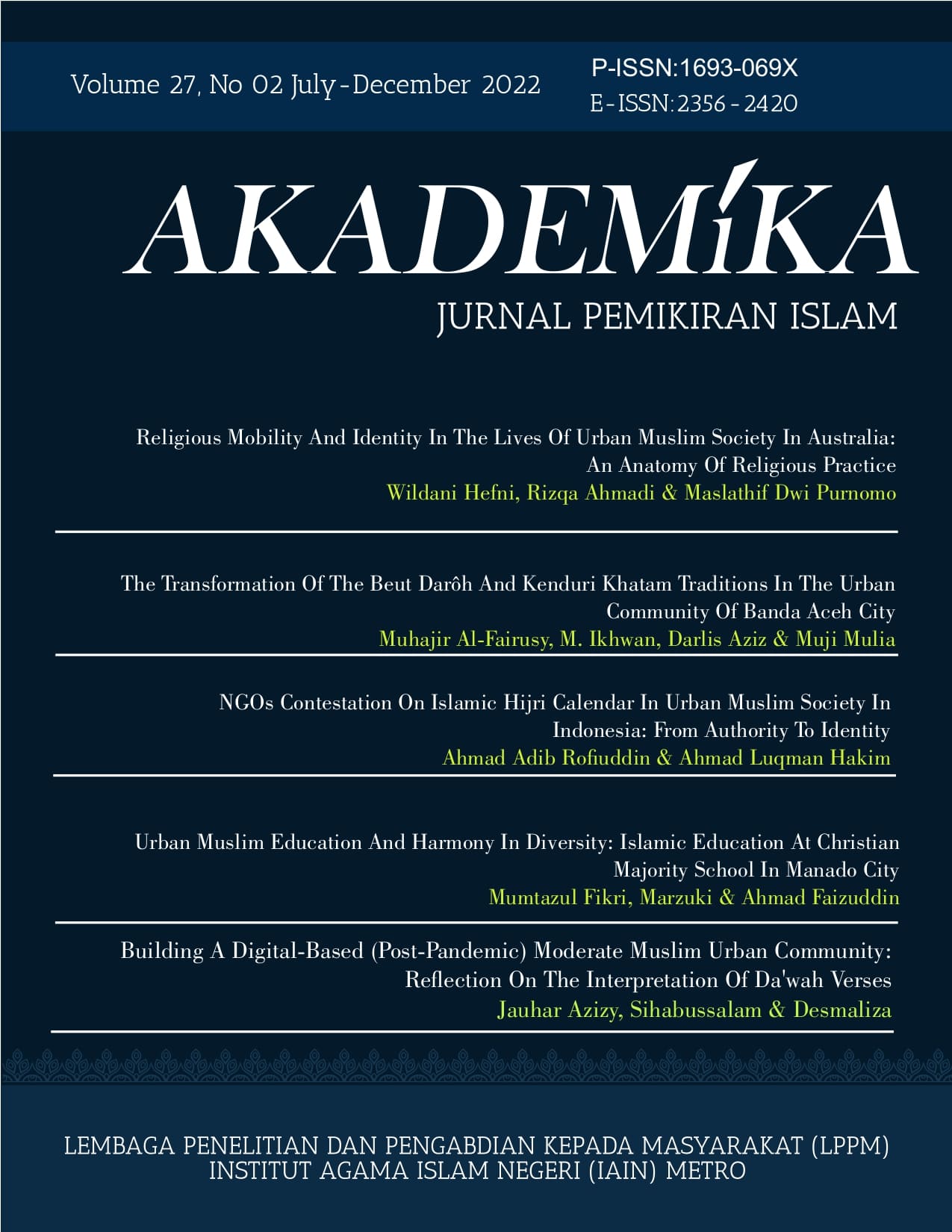NGOs CONTESTATION ON ISLAMIC HIJRI CALENDAR IN URBAN MUSLIM SOCIETY IN INDONESIA: FROM AUTHORITY TO IDENTITY
DOI:
https://doi.org/10.32332/akademika.v27i2.5357Keywords:
Authority, Identity, Islamic Calendar, Indonesian NGOs.Abstract
This article discusses on religious contestation on determination of Islamic Calendar in Urban Muslim society in Indonesia. An Indonesian Islamic calendar discourse is always dominated by Nahdatul Ulama and Muhammadiyah as two largest Islamic NGOs. The choice of individuals from this group to fill the office of Minister of Religious Affairs, the official authority, is a sign of the domination amongst these mass organizations. To analyze the contestation of religious authority, this paper recommends the application of an analytical framework of the Gramsci’s hegemony theory which illustrates the contestation between them. Data were gathered through in-depth interviews with the two organizations' experts in Islamic astronomy, which were then evaluated using a descriptive approach. The finding of this paper reveal that the contestation between Nahdatul Ulama and Muhammadiyah not only in relation to the power, but also strengthening the identity of each group to shows their power on Islamic Calendar discourse in Indonesia.
Downloads
References
AlModarresi, S. M. T., & White, N. M. (2004). Calendar conversion for real-time systems. Advances in Engineering Software, 35(8–9), 511–516. https://doi.org/10.1016/j.advengsoft.2004.05.004.
Amri, R. (2012). Dinamika Penentuan Awal Bulan Kamariyah Menurut Muhammadiyah (Studi Atas Kriteria Wujud al-Hilal dan Konsep Mathla’). At-Taqaddum, 4(129–148).
Anwar, S. (2012). Metode penetapan awal bulan qamariah. Analytica Islamica, 1(1), 32–56.
Arifianto, A. R. (2019). Rising Islamism and the Struggle for Islamic Authority in Post- Reformasi Indonesia. TRaNS: Trans-Regional and -National Studies of Southeast Asia, 1–14. https://doi.org/10.1017/trn.2019.10.
Azhari, S. (2012). Kalender Islam: Ke Arah Integrasi Muhammadiyah-NU. Museum Astronomi Islam.
Azhari, S. (2015). Gagasan Menyatukan Umat Islam Indonesia. Ahkam.
Bruzzi, S., & Zeleke, M. (2015). Contested Religious Authority: Sufi Women in Ethiopia and Eritrea. In Journal of Religion in Africa (Vol. 45, Issue 1). https://doi.org/10.1163/15700666-12340028.
Butar-butar, A. J. R. (2017). Mengenal Karya-Karya Ilmu Falak Nusantara: Transmisi, Anotasi dan Biografi. LKiS.
Distler, W. (2017). The Authority–Identity Relation: Symbolic References and Interpretative Authority in Postwar Kosovo. Journal of Intervention and Statebuilding, 11(4), 429–446. https://doi.org/10.1080/17502977.2017.1385235.
Djamaluddin, T. (2000). Re-evaluation of Hilal Visibility in Indonesia. Warta LAPAN, 4(2).
Djamaluddin, T. (2017). Proposal Ringkas Penyatuan Kalender Islam Global. Seminar Internasional Fikih Falak Di Hotel Aryaduta.
Feener, M. (2007). Muslim Legal Thought in Modern Indonesia. Cambridge University Press.
Hambali, S. (2019, December 12). NU's Rukyat Method. (A. A. Rofiuddin, Interviewer).
Hariwijaya. (2010). Islam Kejawen. Pustaka Pelajar.
Hasyim, S. (2019). Fatwas and Democracy : Majelis Ulama Indonesia ( MUI , Indonesian Ulema Council ) and Rising Conservatism in Indonesian Islam. TRaNS: Trans -Regional and -National Studies of Southeast Asia, 1–15. https://doi.org/10.1017/trn.2019.13.
Hensengerth, O. (2015). Where is the power? Transnational networks, authority and the dispute over the Xayaburi Dam on the Lower Mekong Mainstream. Water International, 40(5–6), 911–928. https://doi.org/10.1080/02508060.2015.1088334.
Ichwan, M. N. (2005). ’ Ulama, State and Politics: Majelis Ulama Indonesia After Suharto. Islamic Law and Society, 12(1), 45–72.
Izzuddin, A. (2007). Fiqih Hisab Rukyat. Erlangga.
Izzuddin, A. (2012). Ilmu Falak Praktis. Pustaka Rizki Putra.
Javornicky, M. (2015). Hidden conflict, resistance and counter-ideology in hegemonic relations of domination. Journal of Political Power, 8(2), 273–280. https://doi.org/10.1080/2158379x.2015.1055952.
Jayusman. (2014). Kebijakan Pemerintah Dalam Penetapan Awal Bulan Kamariah Di Indonesia. MADANIA, 18(2), 185–201.
Jenkins, R. (1992). Key Sociologists: Pierre Bourdieu. Routledge.
Kalmbach, H. (2008). Social and religious change in Damascus: One case of female Islamic religious authority. British Journal of Middle Eastern Studies, 35(1), 37–57. https://doi.org/10.1080/13530190801890238.
Keddie, A. (2014). Political Justice, Schooling and Issues of Group Identity. Educational Philosophy and Theory, 46(3), 311–323. https://doi.org/10.1111/j.1469-5812.2011.00835.x.
Lajnah Falakiyah Pengurus Besar Nahdhatul Ulama. (2006). Pedoman Rukyat dan Hisab Nahdhatul Ulama. LF PBNU.
Liow, J. C. (2009). Piety and Politics: Islamism in Contemporary Malaysia. Oxford University Press.
Long, N. J. (2017). On the Islamic authority of the Indonesian state: responsibility, suspicion, and acts of compliance. Journal of the Royal Anthropological Institute, 23(4), 709–726. https://doi.org/10.1111/1467-9655.12698.
Moller, A. (2005). Ramadhan in Java: The Joy and Jihad of Ritual Fasting. Department of History and Anthropology of Religion.
Nafi’, M. Z. (2019). Beda Lebaran, Warga NU Senang Tetap Harmonis dengan Muhammadiyah. Retrieved February 16, 2019, from https://www.nu.or.id/post/read/54903/beda-lebaran-warga-nu-senang-tetap-harmonis-dengan-muhammadiyah.
Nawawi, A. S. (2010). Ilmu Falak. Aqoba Press.
Odeh, M. S. (2006). New criterion for lunar crescent visibility. Journal of Experimental Astronomy, 18, 39–64. https://doi.org/10.1007/s10686-005-9002-5.
Porter, D. J. (2002). Managing Politics and Islam in Indonesia. Routledge.
Revianur, A. (2018). Muhammadiyah Pastikan Tak Ikut Sidang Isbat. Retrieved October 10, 2018, from https://nasional.kompas.com/read/2012/07/19/1328502/Muhammadiyah.Pastikan.Tak Ikut.Sidang.Isbath.
Rofiuddin, A. A. (2016). Penentuan Hari dalam Sistem Kalender Hijriah. Al-Ahkam, 3(1), 26. https://doi.org/10.21580/ahkam.2016.26.1.878.
Saifullah. (2010). Sejarah dan Kebudayaan Islam di Asia Tenggara. Pustaka Pelajar.
Saksono, T. (2007). Mengkompromikan Rukyat dan Hisab. Amhytas Publicita.
Salim, H. J. (2019). Muhammadiyah Tak Hadir Sidang Isbat, Menag: Waktunya Kurang Tepat. Retrieved November 14, 2019, from https://www.liputan6.com/news/read/633880/muhammadiyah-tak-hadir-sidang-isbat-menag-waktunya-kurang-tepat.
Schwarz, A. (2000). A Nation in Waiting. Westview Press.
Segan, S. (2006). Uncertainties and Misconcepts about Calendars: A Project of A Non-Historical Calendar. Publication of Astronomical Observation Belgrade, 80, 233–244.
Sodli, A. (2017). Dinamika Hubungan Antara Penganut Islam Aboge Dengan Umat Islam Lainnya Di Kabupaten Banyumas. International Journal Ihya’ ’Ulum Al-Din, 18(2), 235. https://doi.org/10.21580/ihya.17.2.1738.
Sudibyo, M. M. (2014). Observasi Hilāl Di Indonesia Dan Signifikansinya Dalam Pembentukan Kriteria Visibilitas Hilāl. Al-Ahkam, 24(1), 113. https://doi.org/10.21580/ahkam.2014.24.1.136.
Sunarwoto. (2015). Contesting Religious Authority: A Study on Dakwah Radio in Surakarta. University of Leiden.
Tim Majelis Tarjih dan Tajdid PP Muhammadiyah. (2009). Pedoman Hisab Muhammadiyah. Majelis Tarjih dan Tajdid PP Muhammadiyah.
Vemia, J. V. (1981). Gramsci’s Political Thought: Hegemony, Consciousness, and the Revolutionary Process. Clarendon Press.
Villegas, M. G. (2004). On pierre bourdieu’s legal thought. Droit et Societe, 56–57(1–2), 57–71.
Wallace, L., & Mullen, A. (2019). Landscape, monumentality and expression of group identities in Iron Age and roman east kent. Britannia, 50, 75–108. https://doi.org/10.1017/S0068113X19000308.
Xin, L. W. (2001). Lunar Visibility and the Islamic Calendar. National University of Singapore.
Yuki, S., & Hiroko, K. (2014). Reconfigurations of Islamic authority in Malaysia. Asian Journal of Social Science, 42(5), 602–619. https://doi.org/10.1163/15685314-04205007.







